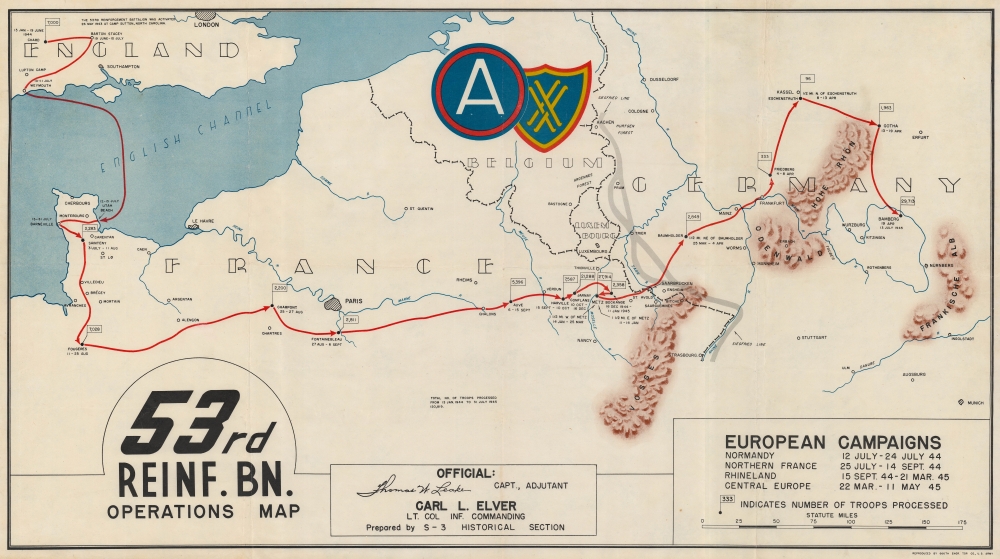This item has been sold, but you can get on the Waitlist to be notified if another example becomes available, or purchase a digital scan.
1945 World War II 53rd Reinforcement Battalion Route Map of Europe
53rdReinfBn-s3-1945$900.00

Title
53rd Reinf. Bn. Operations Map.
1945 (undated) 15.75 x 28 in (40.005 x 71.12 cm) 1 : 1500000
1945 (undated) 15.75 x 28 in (40.005 x 71.12 cm) 1 : 1500000
Description
This is an extremely rare c. 1945 World War II 53rd Reinforcement Battalion route map of Europe. This map follows the 53rd Reinforcement Battalion from Chard, England, to Bamberg, Germany, from January 13, 1944, through July 13, 1945. It also informs on the numbers of reinforcements it processed, illustrating the important role this battalion played in winning World War II.
A Closer Look
A red line traces the battalion's trek across Europe, beginning at Utah Beach on July 12 - 13, 1944. Unlike front line combat troops, the 53rd Reinforcement Battalion stayed in the same place for weeks or months at a time. The cities identified along the battalion's route and the dates when it was in residence are provided. Flags mark battalion encampments and indicate the number of troops processed in each location. A note at bottom center states that 120,819 troops were processed between January 13, 1944, and July 31, 1945. Other major cities are marked, providing geographical context for the battalion's movements. The Siegfried Line appears as well, as do the Vosges, Odenwald, and the Fränkische Alb mountains.Reinforcement Depots and Reinforcement Battalions
The question of how to replace combat losses during World War II was solved by creating a system of reinforcement depots, battalions, and companies. These units worked behind the front lines to train and funnel newly arrived soldiers to front line combat units. Soldiers first arrived at reinforcement depots, which were made up of three corps battalions and three stockage battalions. These units had a stated capacity of 9,600 men, but, at times in the European Theater of Operations, depots operated with three times that number on their rosters. The First Army Depot averaged 11,960 men between August 1, 1944, and May 8, 1945, better known as V-E Day. Then, the reinforcement depot would receive requests for reinforcements from front line units and men would be sent in groups of varying size. When it was practicable, an entire Reinforcement Company was assigned to maintain unit cohesion. When that was not possible, reinforcements were assigned by platoons, squads, or groups of 4. The entire system was overseen by the Ground Force Reinforcement Command (GFRC), which consisted of 15 replacement depots, 79 reinforcement battalions, 377 reinforcement companies, and 19 miscellaneous reinforcement units on V-E Day. The GFRC had a staff of 3,955 officers and 28,474 enlisted men and the GFRC reassigned 1,390,000 reinforcements between January 1, 1944, and May 8, 1945.World War II Route Maps
Maps tracing unit movements during World War II were created by both American and British forces during and after the war. As a genre, these maps represent a broad range of aesthetics, from the purely functional that label places and provide dates, to the artistic, even comic. Many combine the three and provide a visually striking but historically informative summary of the unit's peregrinations.Publication History and Census
This map was prepared by the 53rd Reinforcement Battalion's Operations staff (S-3) and reproduced by the 666th Engineer Topographic Company in 1945. This is the only known cataloged example. As a map for a battalion, it is likely that not many examples of this map were printed, making it rare find in an under appreciated genre.Condition
Very good. Light wear along original fold lines. Verso repair to a fold separation. Verso reinforcement to margin.
References
Klinek, E.W. (2014). The Army's Orphans: The United States Army Replacement System in the European Campaign, 1944 - 1945 [Unpublished doctoral dissertation]. Temple University.

